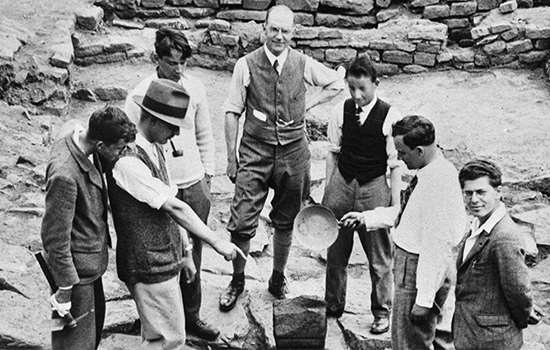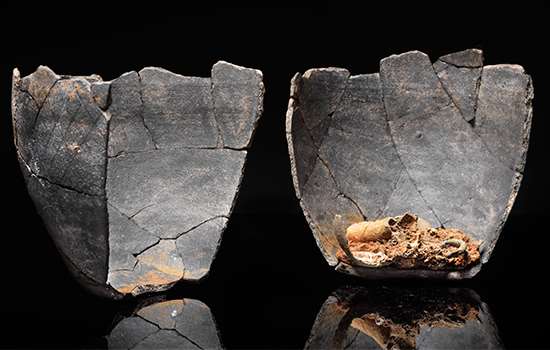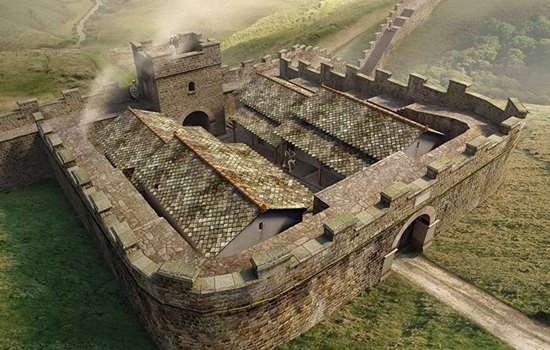From Enemy to Protector
In AD 106, the Dacians (from modern-day Romania) were defeated by Emperor Trajan and the Roman Empire, following a series of brutal campaigns in about AD 100. Proud warriors who fought with their distinctive sword, the falx, the Dacians were later immortalised on Trajan’s Column, depicted as defeated victims in the story of the Roman Empire.
Trajan recruited Dacia’s men to the Roman army as auxiliaries, or non-citizen soldiers. Their story is similar to that of many of the auxiliary units that served in the Roman army.
They were then transferred across the Empire to Britain, a deliberate attempt to break the connection with their homeland – a common Roman policy towards soldiers from recently pacified provinces. Not only did it swell the ranks of the Roman army but it also reduced the risk of their new province rebelling.
After first being based at Bewcastle in the far north east of modern-day Cumbria, by AD 200 the Dacian soldiers had made their way a few miles further south to Birdoswald on Hadrian’s Wall.
It is thought that the Dacians were around 1,000 strong upon arrival at Birdoswald. Soon after their arrival they refitted and adapted the fort to accommodate their needs. They repaired its defences, adjusted the barracks, installed workshops, and built two huge storehouses to help keep the men fed.
The settlements around the fort flourished during their residency, probably filled with families of serving soldiers, veterans and traders, who were vital to the success of the community.
Now generations removed from their homeland, the Dacians were tasked with patrolling and defending the border from raiding. Once bitter enemies, the Dacians had become part of the Roman military machine, trusted protectors of the Empire.
Dacian or Roman?
Even after almost 100 years serving Rome, the self-identity of the Dacians remained curiously ambiguous. One the one hand, they looked typically Roman. The remains of one of the largest series of inscriptions ever found on Hadrian’s Wall demonstrates their conformity to the traditions of the Empire.
Every year, the garrison conducted a ritual to celebrate Jupiter – the chief Roman god. The names of the unit and its commander were recorded on an altar found at Birdoswald. Similar rituals were conducted in every Roman garrison across the Empire as one of many important ceremonies that instilled the soldiers with Roman ideals and loyalty to the emperor. Conformity to Roman military religion shows that the Dacians were firmly part of the army that once conquered them.
But other inscriptions associated with the unit demonstrate something more intriguing – they also retained distinctly Dacian traditions. The name Decius Saxa is recorded on a stone at Birdsowald. Decius was a Roman name and Saxa was a Dacian name. Combining both indicates that a hybrid Dacian–Roman identity was forged as a part of life in the Roman army. Perhaps Decius chose the Latin to demonstrate his new Roman affiliation, but kept Saxa to retain his heritage as a Dacian. Presumably this indicates a level of pride in both cultures.
It is not uncommon to find further evidence of dual cultures on Hadrian’s Wall. At Housesteads, soldiers of Tungrian (Belgian) descent retained part of their Tungrian names. At Chesters Fort the unit of Asturians from northern Spain called their fort Cilurnum, probably after their original tribe name, the Cilurnigi.
Maintaining a close connection to one’s homeland may not be surprising in first generation recruits. Perhaps more striking are the names of subsequent generations of non-soldiers known to have lived in Birdoswald in the 3rd century, some 100 years after the regiment was formed. A fragment of a memorial stone, found in a cemetery, records the tragic death of two young children. One was Blaesus – a traditional Dacian name – and the other was Decabalus, the name of the Dacian king and hero that Trajan had defeated some 100 years previously.
It is likely that these were the children of soldiers, brought up in the civilian settlements around the fort, whose family had preserved a connection with Dacia down many generations. Often children would probably have entered the cohort themselves, so there was clearly no problem in naming a child after a once bitter enemy of Rome, while serving the Empire.
The official records of the unit at Birdoswald also speak to a strong connection between the soldiers and their heritage. When the cohort adjusted and repaired the fort the Dacians proudly boasted of their handiwork. Two inscriptions, one above the massive south granary, the other welcoming visitors above the eastern gate of the fort, proclaim their Dacian origins. In addition to the name of the commander and the unit, each used the symbol of the falx.
By this point further recruitment of soldiers from Britain would have reduced the unit’s direct connection with Dacia. It’s possible that it was the symbol of the falx that bound members of the unit together, irrespective of where they came from.
Who were auxiliary soldiers?
The Roman army was divided into two basic groups: legionaries and auxiliaries. The former were recruited exclusively from the citizens of the Empire. Britain was home to three legions (units of about 5,000 legionaries) that formed the major strength of the Roman army. However, the Roman army relied heavily upon auxiliary units. These were recruited from the many non-Roman citizens who lived within the Empire – often those who had been recently conquered – or even from tribes living outside the Empire. They served in much smaller groups and were often assigned to tasks such as border control where they might deploy specialist skills such as horsemanship or archery.
The results of this recruitment are commonly seen on Hadrian’s Wall. The Asturians based at Chesters Fort were cavalry troops, perfect for quickly patrolling the flat valley of the river Tyne. Archers from Hama in Syria are recorded at Housesteads and are depicted with their traditional equipment and weaponry. This includes the recurved bow, a shorter, more powerful alternative to traditional Roman straight bows.
The auxilia were not just there to swell the ranks of the army. Their fighting ability complemented that of the Roman citizens in the legions and Hadrian’s Wall simply would not have worked without them.
There were great benefits to service as an auxiliary. The pay was good, if not as high as in the legions. If a recruit could survive the many risks of being at the sharp end of Rome’s wars, it was also a path to citizenship. In return for 25 years’ service, all Roman auxiliaries could achieve honesta missio – an honourable discharge – and receive the same rights as all Roman citizens for themselves and their families. A diploma records that the first generation of soldiers serving in the First Cohort of Dacians received these rights at the end of their service in AD 127.
Sometimes the rewards came in other ways. The cohors I Thracium, also present at Birdsowald in the 3rd century, was granted the title civis romanus (citizens of Rome), which indicates that its soldiers had been granted citizenship en masse, presumably for some exceptional act of service.
A Sense of Belonging
During the later 3rd century AD, another unit of auxiliaries arrived at Birdoswald. It appears that the Frisians – from the modern-day Netherlands – continued with their traditional lifestyles, and lived separately from the Dacians. The Frisians lived beyond the fort’s main south gate and walls in wooden-framed buildings – starkly different from the standard military buildings used by the Dacians inside, some of which even had underfloor heating. The Frisians used a distinct type of pottery made only by Frisians, whereas the Dacians used generic Roman pottery.
It is tempting to suggest that there might have been distrust or disharmony between the two units. But by allowing the Frisians to retain their separate heritage, the Roman army had successfully accommodated different traditions in the service of a common cause.
Perhaps surprisingly, at least one group of soldiers at Birdoswald saw themselves as belonging to the Birdoswald community. An altar to the god Silvanus was found at Birdsowald dedicated by the venatores Bannienses – the Hunters of Banna (Birdoswald). By identifying themselves in this way, the authors were stating that they belonged to the place, not an ethnicity or army.
Unfortunately, it is impossible to know who these hunters were. Perhaps they were Frisians, perhaps Dacians, or even both. But, whoever they were, they were proud to belong to the place in which they lived.
MAKING BIRDOSWALD HOME
The Dacians certainly felt a strong connection to the local spiritual landscape. The worshipped the traditional Roman gods, such as Jupiter at Birdoswald, but an altar to the Celtic goddess Dea Latis was also discovered at the fort. It was common across Hadrian’s Wall for the soldiers to worship local gods and visit nearby sacred sites and it is likely that members of the Dacian cohort and the wider community participated in the worship of Dea Latis.
Similarly dedications to the god Cocidius have also been discovered at Birdoswald. Cocidius was a native British god who attracted military followers due to his similarity to the Roman god Mars. Ritual activity has been located at both the known bases of the Dacians, Birdoswald and Bewcastle, suggesting that Cocidius was particularly important to the cohort.
When, in AD 410, Rome withdrew support for the British garrison, the soldiers of Britain faced a choice. Would they stay part of the military communities or leave Britain altogether? There is evidence at Birdoswald that at least some of the community stayed. We cannot know who the late garrison was, but it is tantalising to think that some 300 years after coming to Britain the descendants of the Dacians saw Birdoswald as their permanent home.
By Andrew J. Roberts with additional research by Alexandra M. Ivens
Explore More
-

Uncovering the Secrets of Hadrian’s Wall
The remains of Birdoswald Roman Fort have revealed more about Hadrian’s Wall than any other site along Wall. Discover what some of the key finds tell us about the Romans and those who came after.
-

Death and burial rites at Birdoswald
A rare excavation of burial urns found at Birdoswald has allowed researchers to examine the remains of those who lived and died at the fort. Discover what the new research reveals.
-

Birdoswald: History and Stories
Explore Birdoswald through time and learn about the community who travelled across the Empire and made the fort their home.
-

Hadrian’s Wall: History and Stories
Discover the histories, stories and mysteries associated with English Heritage’s Hadrian’s Wall sites.
